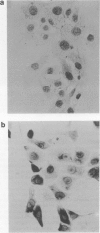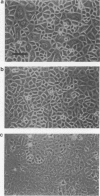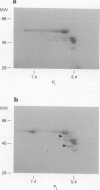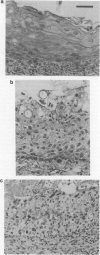Abstract
We introduced the origin-defective SV40 early gene into cultured human oesophageal epithelial cells by infection of a recombinant SV40 adenovirus vector. The virus-infected cells formed colonies 3-4 weeks after infection in medium containing fetal calf serum. When the cells derived from 'serum-resistant' colonies were then maintained in the serum-free medium with a low calcium ion concentration, some of them passed the cell crisis and kept growing for over 12 months. These cells, regarded as immortalised cells, resembled the primarily cultured oesophageal epithelial cells in morphology and had some of their original characteristics. Treatment of the cells with a high calcium concentration induced phenotypic changes. These cells still responded to transforming growth factor beta. When the immortalised cells were injected into severe combined immunodeficient mice, they transiently formed epithelial cysts, although the typical differentiation pattern of the oesophageal epithelium was not observed. These cysts regressed within 2 months without development into tumours. The results indicated that human oesophageal epithelial cells were reproducibly immortalised by infection with a recombinant SV40 adenovirus vector at relatively high efficiency. The immortalised cells should be useful in studies on oesophageal carcinogenesis and in assessing the cooperative effects with other oncogene products or carcinogens.
Full text
PDF
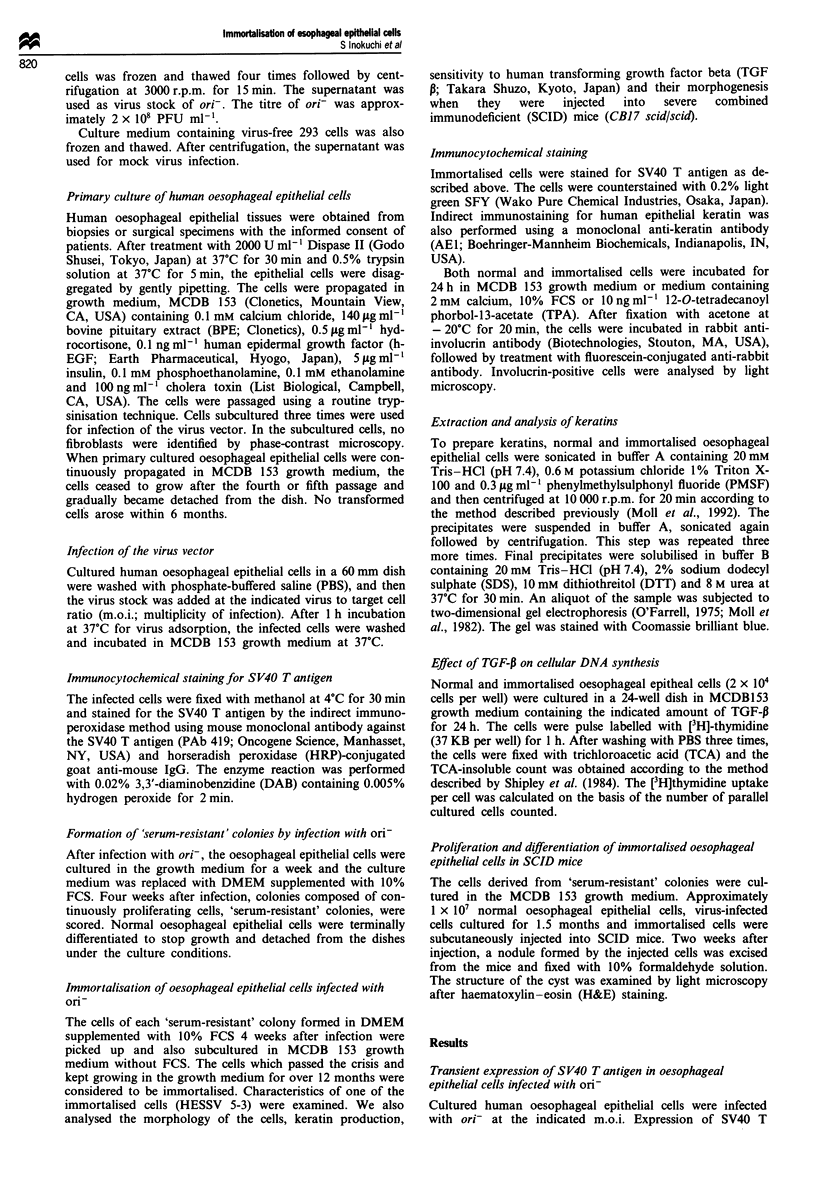


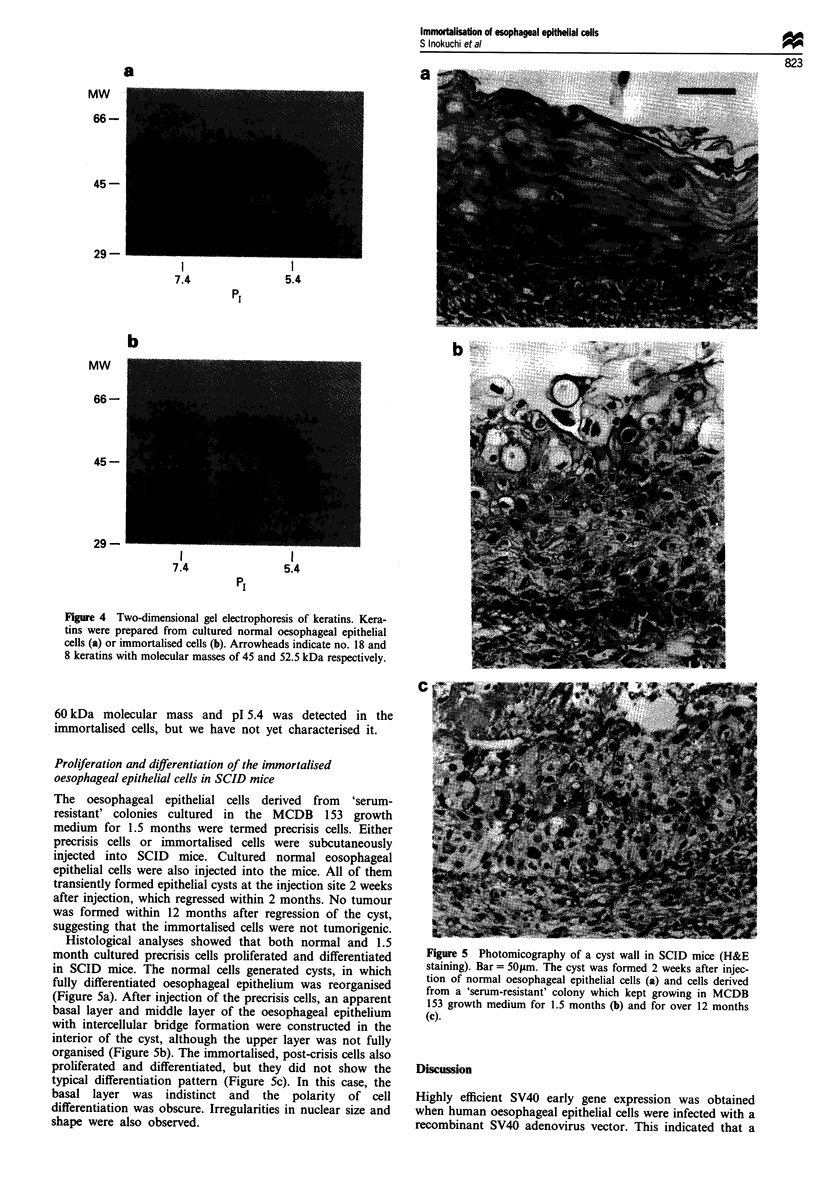
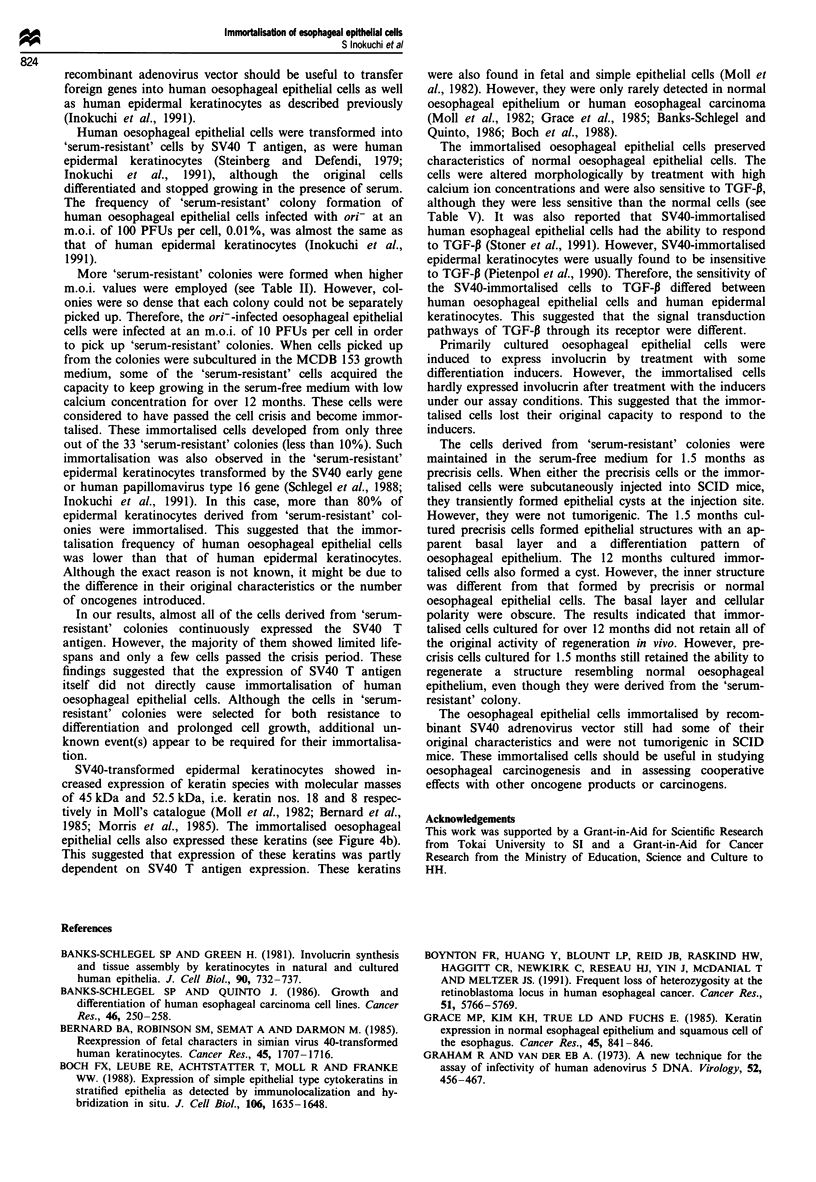
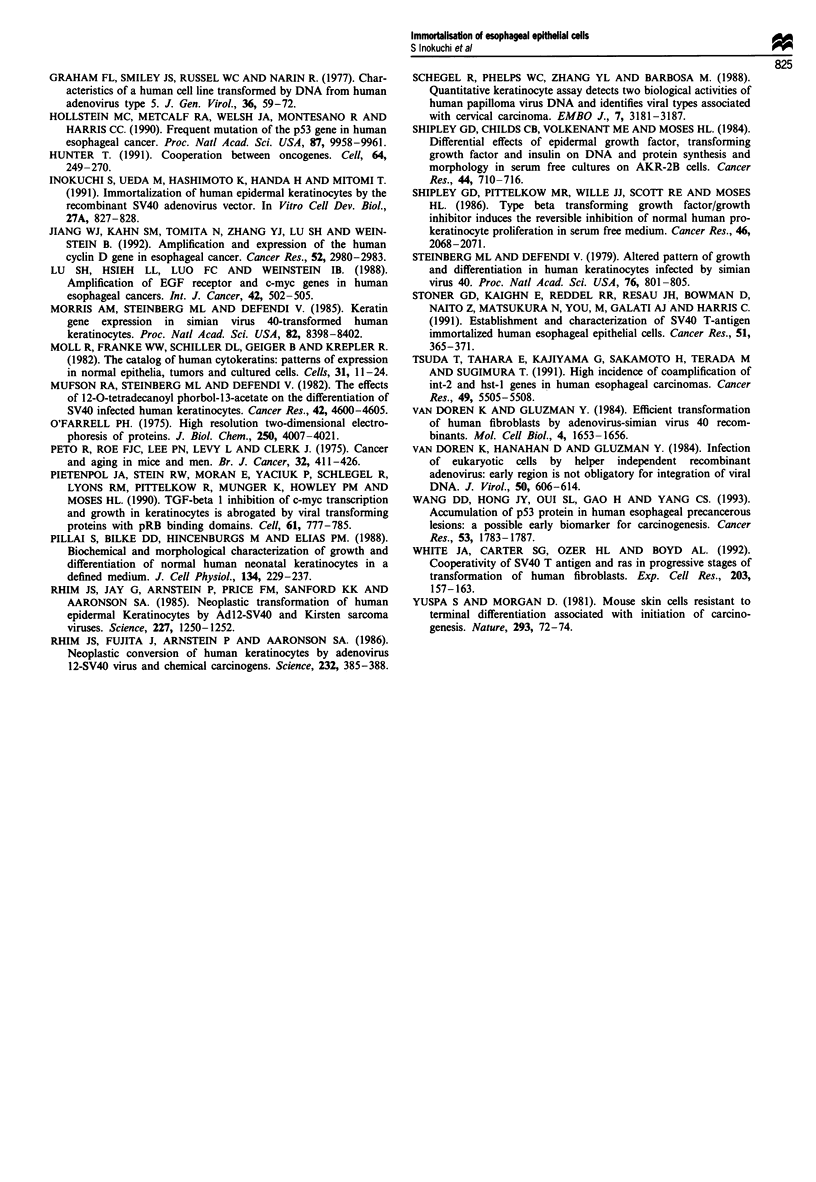
Images in this article
Selected References
These references are in PubMed. This may not be the complete list of references from this article.
- Banks-Schlegel S. P., Quintero J. Growth and differentiation of human esophageal carcinoma cell lines. Cancer Res. 1986 Jan;46(1):250–258. [PubMed] [Google Scholar]
- Banks-Schlegel S., Green H. Involucrin synthesis and tissue assembly by keratinocytes in natural and cultured human epithelia. J Cell Biol. 1981 Sep;90(3):732–737. doi: 10.1083/jcb.90.3.732. [DOI] [PMC free article] [PubMed] [Google Scholar]
- Bernard B. A., Robinson S. M., Semat A., Darmon M. Reexpression of fetal characters in simian virus 40-transformed human keratinocytes. Cancer Res. 1985 Apr;45(4):1707–1716. [PubMed] [Google Scholar]
- Bosch F. X., Leube R. E., Achtstätter T., Moll R., Franke W. W. Expression of simple epithelial type cytokeratins in stratified epithelia as detected by immunolocalization and hybridization in situ. J Cell Biol. 1988 May;106(5):1635–1648. doi: 10.1083/jcb.106.5.1635. [DOI] [PMC free article] [PubMed] [Google Scholar]
- Boynton R. F., Huang Y., Blount P. L., Reid B. J., Raskind W. H., Haggitt R. C., Newkirk C., Resau J. H., Yin J., McDaniel T. Frequent loss of heterozygosity at the retinoblastoma locus in human esophageal cancers. Cancer Res. 1991 Oct 15;51(20):5766–5769. [PubMed] [Google Scholar]
- Grace M. P., Kim K. H., True L. D., Fuchs E. Keratin expression in normal esophageal epithelium and squamous cell carcinoma of the esophagus. Cancer Res. 1985 Feb;45(2):841–846. [PubMed] [Google Scholar]
- Graham F. L., van der Eb A. J. A new technique for the assay of infectivity of human adenovirus 5 DNA. Virology. 1973 Apr;52(2):456–467. doi: 10.1016/0042-6822(73)90341-3. [DOI] [PubMed] [Google Scholar]
- Hollstein M. C., Metcalf R. A., Welsh J. A., Montesano R., Harris C. C. Frequent mutation of the p53 gene in human esophageal cancer. Proc Natl Acad Sci U S A. 1990 Dec;87(24):9958–9961. doi: 10.1073/pnas.87.24.9958. [DOI] [PMC free article] [PubMed] [Google Scholar]
- Hunter T. Cooperation between oncogenes. Cell. 1991 Jan 25;64(2):249–270. doi: 10.1016/0092-8674(91)90637-e. [DOI] [PubMed] [Google Scholar]
- Inokuchi S., Hashimoto K., Mitomi T., Ueda M., Handa H. Immortalization of human epidermal keratinocytes by the recombinant SV40 adenovirus vector. In Vitro Cell Dev Biol. 1991 Nov;27A(11):827–828. doi: 10.1007/BF02630980. [DOI] [PubMed] [Google Scholar]
- Jiang W., Kahn S. M., Tomita N., Zhang Y. J., Lu S. H., Weinstein I. B. Amplification and expression of the human cyclin D gene in esophageal cancer. Cancer Res. 1992 May 15;52(10):2980–2983. [PubMed] [Google Scholar]
- Lu S. H., Hsieh L. L., Luo F. C., Weinstein I. B. Amplification of the EGF receptor and c-myc genes in human esophageal cancers. Int J Cancer. 1988 Oct 15;42(4):502–505. doi: 10.1002/ijc.2910420406. [DOI] [PubMed] [Google Scholar]
- Moll R., Franke W. W., Schiller D. L., Geiger B., Krepler R. The catalog of human cytokeratins: patterns of expression in normal epithelia, tumors and cultured cells. Cell. 1982 Nov;31(1):11–24. doi: 10.1016/0092-8674(82)90400-7. [DOI] [PubMed] [Google Scholar]
- Mufson R. A., Steinberg M. L., Defendi V. Effects of 12-O-tetradecanoylphorbol-13-acetate on the differentiation of simian virus 40-infected human keratinocytes. Cancer Res. 1982 Nov;42(11):4600–4605. [PubMed] [Google Scholar]
- O'Farrell P. H. High resolution two-dimensional electrophoresis of proteins. J Biol Chem. 1975 May 25;250(10):4007–4021. [PMC free article] [PubMed] [Google Scholar]
- Peto R., Roe F. J., Lee P. N., Levy L., Clack J. Cancer and ageing in mice and men. Br J Cancer. 1975 Oct;32(4):411–426. doi: 10.1038/bjc.1975.242. [DOI] [PMC free article] [PubMed] [Google Scholar]
- Pietenpol J. A., Stein R. W., Moran E., Yaciuk P., Schlegel R., Lyons R. M., Pittelkow M. R., Münger K., Howley P. M., Moses H. L. TGF-beta 1 inhibition of c-myc transcription and growth in keratinocytes is abrogated by viral transforming proteins with pRB binding domains. Cell. 1990 Jun 1;61(5):777–785. doi: 10.1016/0092-8674(90)90188-k. [DOI] [PubMed] [Google Scholar]
- Pillai S., Bikle D. D., Hincenbergs M., Elias P. M. Biochemical and morphological characterization of growth and differentiation of normal human neonatal keratinocytes in a serum-free medium. J Cell Physiol. 1988 Feb;134(2):229–237. doi: 10.1002/jcp.1041340208. [DOI] [PubMed] [Google Scholar]
- Rhim J. S., Fujita J., Arnstein P., Aaronson S. A. Neoplastic conversion of human keratinocytes by adenovirus 12-SV40 virus and chemical carcinogens. Science. 1986 Apr 18;232(4748):385–388. doi: 10.1126/science.2421406. [DOI] [PubMed] [Google Scholar]
- Rhim J. S., Jay G., Arnstein P., Price F. M., Sanford K. K., Aaronson S. A. Neoplastic transformation of human epidermal keratinocytes by AD12-SV40 and Kirsten sarcoma viruses. Science. 1985 Mar 8;227(4691):1250–1252. doi: 10.1126/science.2579430. [DOI] [PubMed] [Google Scholar]
- Schlegel R., Phelps W. C., Zhang Y. L., Barbosa M. Quantitative keratinocyte assay detects two biological activities of human papillomavirus DNA and identifies viral types associated with cervical carcinoma. EMBO J. 1988 Oct;7(10):3181–3187. doi: 10.1002/j.1460-2075.1988.tb03185.x. [DOI] [PMC free article] [PubMed] [Google Scholar]
- Shipley G. D., Childs C. B., Volkenant M. E., Moses H. L. Differential effects of epidermal growth factor, transforming growth factor, and insulin on DNA and protein synthesis and morphology in serum-free cultures of AKR-2B cells. Cancer Res. 1984 Feb;44(2):710–716. [PubMed] [Google Scholar]
- Shipley G. D., Pittelkow M. R., Wille J. J., Jr, Scott R. E., Moses H. L. Reversible inhibition of normal human prokeratinocyte proliferation by type beta transforming growth factor-growth inhibitor in serum-free medium. Cancer Res. 1986 Apr;46(4 Pt 2):2068–2071. [PubMed] [Google Scholar]
- Steinberg M. L., Defendi V. Altered pattern of growth and differentiation in human keratinocytes infected by simian virus 40. Proc Natl Acad Sci U S A. 1979 Feb;76(2):801–805. doi: 10.1073/pnas.76.2.801. [DOI] [PMC free article] [PubMed] [Google Scholar]
- Stoner G. D., Kaighn M. E., Reddel R. R., Resau J. H., Bowman D., Naito Z., Matsukura N., You M., Galati A. J., Harris C. C. Establishment and characterization of SV40 T-antigen immortalized human esophageal epithelial cells. Cancer Res. 1991 Jan 1;51(1):365–371. [PubMed] [Google Scholar]
- Tsuda T., Tahara E., Kajiyama G., Sakamoto H., Terada M., Sugimura T. High incidence of coamplification of hst-1 and int-2 genes in human esophageal carcinomas. Cancer Res. 1989 Oct 15;49(20):5505–5508. [PubMed] [Google Scholar]
- Van Doren K., Gluzman Y. Efficient transformation of human fibroblasts by adenovirus-simian virus 40 recombinants. Mol Cell Biol. 1984 Aug;4(8):1653–1656. doi: 10.1128/mcb.4.8.1653. [DOI] [PMC free article] [PubMed] [Google Scholar]
- Van Doren K., Hanahan D., Gluzman Y. Infection of eucaryotic cells by helper-independent recombinant adenoviruses: early region 1 is not obligatory for integration of viral DNA. J Virol. 1984 May;50(2):606–614. doi: 10.1128/jvi.50.2.606-614.1984. [DOI] [PMC free article] [PubMed] [Google Scholar]
- Wang L. D., Hong J. Y., Qiu S. L., Gao H., Yang C. S. Accumulation of p53 protein in human esophageal precancerous lesions: a possible early biomarker for carcinogenesis. Cancer Res. 1993 Apr 15;53(8):1783–1787. [PubMed] [Google Scholar]
- White J. A., Carter S. G., Ozer H. L., Boyd A. L. Cooperativity of SV40 T antigen and ras in progressive stages of transformation of human fibroblasts. Exp Cell Res. 1992 Nov;203(1):157–163. doi: 10.1016/0014-4827(92)90051-9. [DOI] [PubMed] [Google Scholar]
- Yuspa S. H., Morgan D. L. Mouse skin cells resistant to terminal differentiation associated with initiation of carcinogenesis. Nature. 1981 Sep 3;293(5827):72–74. doi: 10.1038/293072a0. [DOI] [PubMed] [Google Scholar]




